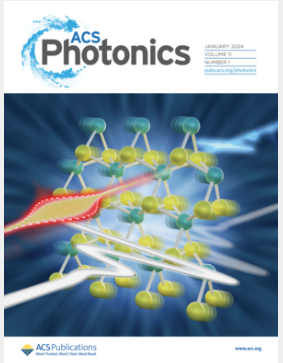通过表面光子捕获孔阵列增强硅基硒化铅薄膜 MSM 光电探测器的响应能力
IF 6.7
1区 物理与天体物理
Q1 MATERIALS SCIENCE, MULTIDISCIPLINARY
引用次数: 0
摘要
在表面集成光子捕获孔阵列的硅基硒化铅薄膜金属-半导体-金属(MSM)光电探测器在宽光谱范围内具有更高的效率。基于有限差分时域法,研究了薄膜厚度、衬底、孔结构(直径、周期和深度)和顶部电极对光电探测器红外吸收的影响,以优化器件结构。光子捕获孔阵列有效地减少了表面反射,并使垂直入射光在器件内形成横向慢速传播模式,从而增强了吸收。此外,还可以通过改变孔的周期来调整吸收峰值波长。我们制作了几种具有不同孔结构的硅基硒化铅薄膜 MSM 光电探测器,测得的效率与红外吸收的理论预测值非常吻合。在直径/周期比(d/p)为 700/1000 nm 的方形晶格中具有孔阵列的光电探测器在 808 nm 波长处的响应率为 0.449 A/W。与没有孔结构的器件相比,808、1064、1310 和 1550 纳米波长的响应率分别显著提高了 225%、267%、334% 和 357%。在 808 纳米波段和 1550 纳米波段的比检测率分别达到 1.474 × 109 琼斯和 9.3 × 108 琼斯。这项研究为在宽光谱范围内实现高效率的硅基单芯片集成光电二极管提供了一种新方法,这使得微孔支持的硅基 PbSe MSM 光电二极管有望覆盖 C、L 甚至更宽的波段,用于低成本红外传感和通信应用。本文章由计算机程序翻译,如有差异,请以英文原文为准。

Enhanced Response of Si-Based PbSe Thin Film MSM Photodetectors by Photon-Trapping Hole Array in the Surface
A Si-based PbSe thin film metal–semiconductor–metal (MSM) photodetector with enhanced efficiency in a wide spectral range is demonstrated with an integrated photon-trapping hole array in the surface. Based on the finite difference time domain method, the effects of film thickness, substrate, hole structure (diameter, period, and depth), and top electrodes on the infrared absorption of the photodetector are studied to optimize the device structure. The photon-trapping hole array effectively reduces the surface reflection and induces laterally slow propagating modes of the vertically incident light within the device, thereby achieving enhanced absorption. Additionally, the peak absorption wavelength can be tuned by changing the period of the holes. Several Si-based PbSe thin film MSM photodetectors with various hole structures are fabricated, and the measured efficiency agrees well with the theoretical prediction of infrared absorption. The photodetector with a hole array in a square lattice with a diameter/period ratio (d/p) of 700/1000 nm achieves a responsivity of 0.449 A/W at 808 nm. Compared to the device without hole structures, the responsivities at 808, 1064, 1310, and 1550 nm show significant enhancements of 225%, 267%, 334%, and 357%, respectively. The specific detectivity reaches 1.474 × 109 Jones at 808 nm and 9.3 × 108 Jones at 1550 nm. This study provides a new approach for the Si-based single-chip-integrated photodetectors with high efficiency over a broad spectral range, which makes the microhole-enabled Si-based PbSe MSM photodiodes promising to cover C, L, and even wider bands for low-cost infrared sensing and communication applications.
求助全文
通过发布文献求助,成功后即可免费获取论文全文。
去求助
来源期刊

ACS Photonics
NANOSCIENCE & NANOTECHNOLOGY-MATERIALS SCIENCE, MULTIDISCIPLINARY
CiteScore
11.90
自引率
5.70%
发文量
438
审稿时长
2.3 months
期刊介绍:
Published as soon as accepted and summarized in monthly issues, ACS Photonics will publish Research Articles, Letters, Perspectives, and Reviews, to encompass the full scope of published research in this field.
 求助内容:
求助内容: 应助结果提醒方式:
应助结果提醒方式:


